Product Description
| Model | Effective width of machine slot(cm) | Yield(m³/H) |
| TGSS16 | 16 | 30 |
| TGSS20 | 20 | 55 |
| TGSS25 | 25 | 90 |
| TGSS32 | 32 | 130 |
| TGSS40 | 40 | 270 |
| TGSS50 | 50 | 400 |
The drag conveyor is made up with Machine head,machine body,machine tail,inlet and outlet.
(1) The machine head is made up with the main body box,drive sprocket,Gear box, transmission sprocket.Chain and drags.
(2) The tail is made up with main body box,sprocket,tensioning device.
(3) The intermediate body is made up with the tube ,slide rail chain & drags,machine cover etc.
(4) The inlet and outlet are made up with the flange and connecting joints used for input or discharge of the grain.
(5) Chain has T and V type,it is the main part of the conveyor for transportation of the grain.
(6)1t is a kind of gear box transmission ed through the chain and head shaft The drag chain conveyor is widely used in the port industry, grain warehouse,malt industry,brewery industry,feed mill company,oil factory and so on.
ZheJiang CHINAMFG Grain Steel Silo Company Ltd. is a leading supplier of grain storage solutions in China, dedicated to providing one-stop grain storage and supporting solutions for global customers.
The company was founded in 2007, and now has more than 30 invention patents and utility model patents, nearly 8,000 square CHINAMFG of dust-free workshop, equipped with the most advanced automatic laser cutting machine, CNC lathe, metal bending machine and automatic shearing The company has more than 10 professional designers and engineers, and hundreds of factory managers, workshop directors, production schedulers, skilled workers and installers.
1.who are you?
We are professional silo manufacturer and solution provider start from 2007 based in ZheJiang , China with 14 years experience in overseas trading.
2.how can you guarantee quality?
We have got CE, ISO9001certificates and many patents.
3.what can we buy from you?
Grain Silos, ventilation system, level sensor,silo intelligent cloud management system, weighing sensor system,sweep auger,temperature monitoring system,cooler,fumigation system for steel silo, electric control system, bucket elevator,drag conveyor, screw conveyor, belt conveyor,pneumatic conveyor, pre-cleaner, vibrating cleaner, pulse dust collector,cyclone,suction separator, magnetic drum.
4: I want to use our own brand , is it ok?
Of course it’s OK , we can make OEM products if your MOQ is 2 sets, and we can also can provide our own brand products
5:When you ship my order?
Normally 15-30 days after receiving your payment, but it can be negotiated based on order qty and production schedule.
6.what services can you provide?
Accepted Delivery Terms: FOB,CIF,EXW
Accepted Payment Currency:USD,CNY
Accepted Payment Type: T/T,L/C
Language Spoken:English,Chinese
7:How about the warranty ?
One year warranty .
| After-sales Service: | 24 Hours Online |
|---|---|
| Warranty: | One Year |
| Structure: | Conveyor System |
| Material: | Carbon Steel |
| Material Feature: | Oil Resistant, Heat Resistant, Fire Resistant |
| Application: | Grain Transport, Grain,Foodstuff,Oil,Feed Industries |
| Customization: |
Available
| Customized Request |
|---|
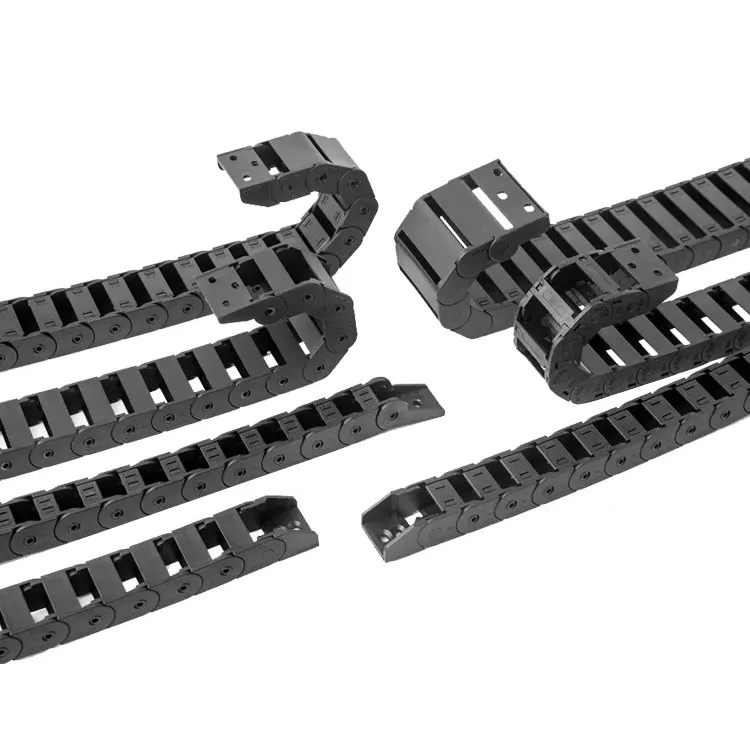
What are the temperature limits for drag chains in extreme environments?
Drag chains are designed to operate in a wide range of temperatures, but their temperature limits can vary depending on the materials used in their construction. In extreme environments, such as those with high or low temperatures, it is essential to select the appropriate drag chain that can withstand the specific conditions. Here are some general temperature guidelines for drag chains:
- Standard Drag Chains: Most standard drag chains can typically handle temperatures ranging from -40°C to 80°C (-40°F to 176°F). These are suitable for many industrial applications with moderate temperature variations.
- High-Temperature Drag Chains: For applications that involve higher temperatures, specialized high-temperature drag chains are available. These can handle temperatures up to 250°C (482°F) or even higher, depending on the materials used, making them suitable for use in hot environments like foundries or ovens.
- Low-Temperature Drag Chains: In cold environments, where temperatures can drop significantly below freezing, low-temperature drag chains are used. These can withstand temperatures as low as -50°C (-58°F) and are commonly used in freezer storage systems or cold storage facilities.
- Heat-Resistant Materials: Drag chains can be manufactured using various heat-resistant materials, such as stainless steel, special plastics, or composite materials, to withstand extreme temperature conditions without compromising their performance.
It is crucial to consult with the drag chain manufacturer or supplier to ensure that the selected drag chain is suitable for the specific temperature range of the environment in which it will be used. Using drag chains with appropriate temperature limits helps to maintain reliable cable protection and system performance even in extreme conditions.
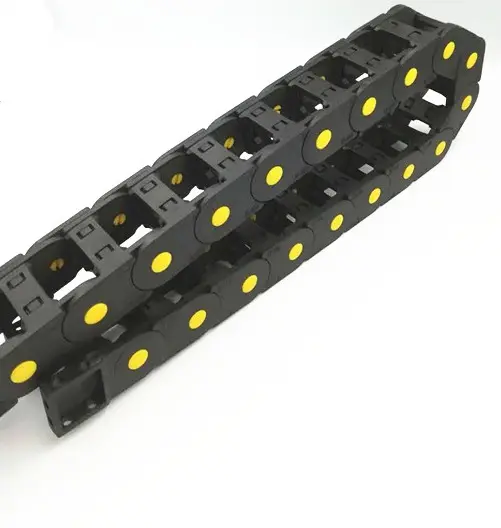
Can drag chains be used in the mining and construction industries?
Yes, drag chains can be used in the mining and construction industries for various applications that involve the management and protection of cables and hoses. These industries often operate in rugged and harsh environments where heavy machinery and equipment are utilized. Drag chains, also known as cable carriers or energy chains, play a crucial role in cable and hose management, providing reliable protection and organization.
In the mining and construction sectors, drag chains are commonly used in the following ways:
- Cable and Hose Protection: Drag chains protect cables, hoses, and other vital components from abrasion, impact, and environmental factors. In mining and construction, where heavy equipment and materials are in constant motion, drag chains prevent damage to essential cables, ensuring continuous operation and reducing downtime.
- Heavy-Duty Applications: Drag chains are designed to handle heavy loads and dynamic movements, making them suitable for the robust and demanding nature of mining and construction equipment. They can withstand the stresses of continuous motion, vibrations, and exposure to dust, debris, and moisture.
- Long Travel Distances: In large-scale mining and construction operations, drag chains are used for long travel distances, such as in conveyor systems or in equipment with extended reach. They provide a reliable method of guiding and protecting cables and hoses over significant distances.
- Resistance to Harsh Environments: Drag chains are available in materials that offer high resistance to chemicals, UV radiation, and extreme temperatures, making them suitable for the challenging conditions often encountered in mining and construction sites.
- Customizable Solutions: Drag chains can be customized to accommodate specific cable and hose configurations, allowing for efficient cable management in complex machinery and equipment used in the mining and construction industries.
Overall, drag chains contribute to improved safety, reduced maintenance costs, and enhanced operational efficiency in the mining and construction sectors. By protecting cables and hoses from damage and maintaining organized routing, drag chains help ensure smooth and reliable operations of critical equipment.
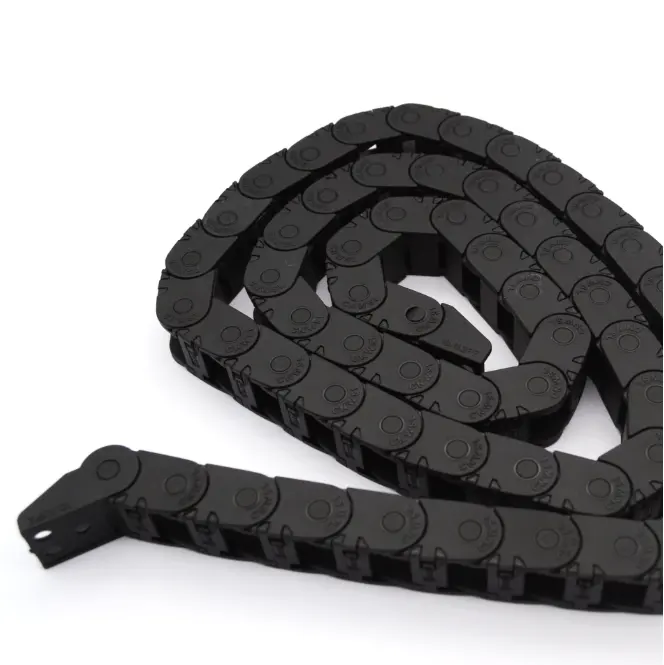
How do drag chains prevent cable wear and ensure smooth cable movement?
Drag chains, also known as cable carriers or cable chains, play a crucial role in protecting cables and hoses while ensuring their smooth movement in industrial applications. Here’s how they achieve this:
1. Enclosed Design:
Drag chains have an enclosed design with a series of interconnected links that form a protective channel for the cables and hoses inside. This design prevents external elements like dust, debris, and liquids from coming into direct contact with the cables, reducing the risk of abrasion and wear.
2. Cable Separation:
The individual links in the drag chain keep the cables and hoses separated from each other, preventing them from getting tangled or rubbing against each other. This separation minimizes friction and wear between the cables, ensuring their longevity.
3. Cable Support:
Drag chains provide excellent support for the cables and hoses they carry. The cables rest on the bottom of the chain’s channel, and the smooth movement of the chain prevents excessive bending or twisting, reducing the stress on the cables and prolonging their life.
4. Low Friction Materials:
High-quality drag chains are made from low-friction materials like nylon or plastic, reducing the friction between the cables and the chain itself. This feature ensures that the cables can move freely inside the chain without experiencing excessive wear.
5. Tension Adjustment:
Many drag chains allow for adjustable tension, which means that the user can adjust the tightness of the chain according to the number and size of the cables or hoses. Proper tension prevents slack and excessive movement, reducing the risk of wear due to movement-related stress.
6. Suitable Material Selection:
Choosing the right type of drag chain and material is essential to prevent cable wear. The chain’s material should be compatible with the cables it will carry and the environmental conditions in which it will operate. Stainless steel, plastic, and hybrid materials are commonly used for different applications.
7. Regular Inspection and Maintenance:
Regular inspection and maintenance of drag chains are vital to ensure their optimal performance. This includes cleaning the chain, checking for any signs of wear or damage, and making any necessary adjustments or replacements.
In conclusion, drag chains prevent cable wear and ensure smooth cable movement by providing an enclosed, separated, and well-supported channel for the cables and hoses. The right material selection, tension adjustment, and regular maintenance further contribute to the effective protection and longevity of the cables in industrial applications.


editor by CX 2023-11-20
China manufacturer Reliable Quality Grain Transporting Drag Conveyor Chain Factory Price for Sale
Product Description
| Model | Effective width of machine slot(cm) | Yield(m³/H) |
| TGSS16 | 16 | 30 |
| TGSS20 | 20 | 55 |
| TGSS25 | 25 | 90 |
| TGSS32 | 32 | 130 |
| TGSS40 | 40 | 270 |
| TGSS50 | 50 | 400 |
The drag conveyor is made up with Machine head,machine body,machine tail,inlet and outlet.
(1) The machine head is made up with the main body box,drive sprocket,Gear box, transmission sprocket.Chain and drags.
(2) The tail is made up with main body box,sprocket,tensioning device.
(3) The intermediate body is made up with the tube ,slide rail chain & drags,machine cover etc.
(4) The inlet and outlet are made up with the flange and connecting joints used for input or discharge of the grain.
(5) Chain has T and V type,it is the main part of the conveyor for transportation of the grain.
(6)1t is a kind of gear box transmission ed through the chain and head shaft The drag chain conveyor is widely used in the port industry, grain warehouse,malt industry,brewery industry,feed mill company,oil factory and so on.
ZheJiang CHINAMFG Grain Steel Silo Company Ltd. is a leading supplier of grain storage solutions in China, dedicated to providing one-stop grain storage and supporting solutions for global customers.
The company was founded in 2007, and now has more than 30 invention patents and utility model patents, nearly 8,000 square CHINAMFG of dust-free workshop, equipped with the most advanced automatic laser cutting machine, CNC lathe, metal bending machine and automatic shearing The company has more than 10 professional designers and engineers, and hundreds of factory managers, workshop directors, production schedulers, skilled workers and installers.
1.who are you?
We are professional silo manufacturer and solution provider start from 2007 based in ZheJiang , China with 14 years experience in overseas trading.
2.how can you guarantee quality?
We have got CE, ISO9001certificates and many patents.
3.what can we buy from you?
Grain Silos, ventilation system, level sensor,silo intelligent cloud management system, weighing sensor system,sweep auger,temperature monitoring system,cooler,fumigation system for steel silo, electric control system, bucket elevator,drag conveyor, screw conveyor, belt conveyor,pneumatic conveyor, pre-cleaner, vibrating cleaner, pulse dust collector,cyclone,suction separator, magnetic drum.
4: I want to use our own brand , is it ok?
Of course it’s OK , we can make OEM products if your MOQ is 2 sets, and we can also can provide our own brand products
5:When you ship my order?
Normally 15-30 days after receiving your payment, but it can be negotiated based on order qty and production schedule.
6.what services can you provide?
Accepted Delivery Terms: FOB,CIF,EXW
Accepted Payment Currency:USD,CNY
Accepted Payment Type: T/T,L/C
Language Spoken:English,Chinese
7:How about the warranty ?
One year warranty .
| After-sales Service: | 24 Hours Online |
|---|---|
| Warranty: | One Year |
| Structure: | Conveyor System |
| Material: | Carbon Steel |
| Material Feature: | Oil Resistant, Heat Resistant, Fire Resistant |
| Application: | Grain Transport, Grain,Foodstuff,Oil,Feed Industries |
| Customization: |
Available
| Customized Request |
|---|
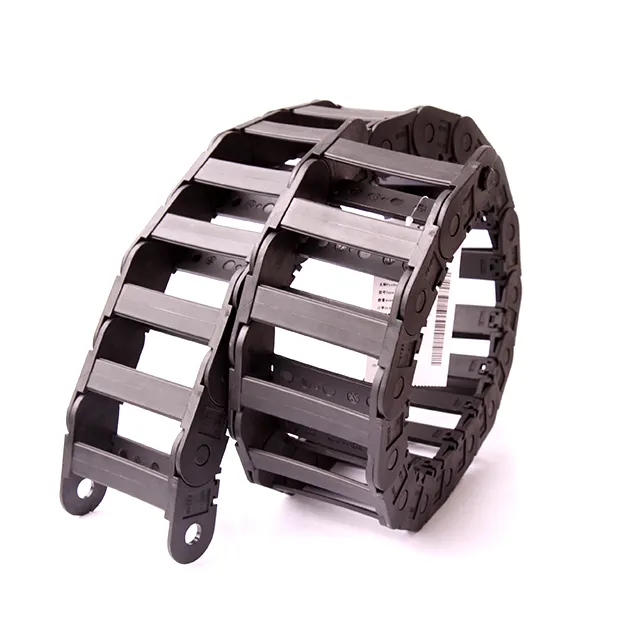
What are the factors to consider when selecting a drag chain for specific cable management needs?
When selecting a drag chain for specific cable management needs, several factors should be taken into consideration to ensure optimal performance and longevity. Here are some key factors to keep in mind:
- Load Capacity: Determine the total weight of the cables and hoses that will be placed inside the drag chain. Select a drag chain with a load capacity that exceeds the total weight to prevent overloading.
- Internal Height and Width: Measure the diameter and height of the largest cable or hose in the system. The internal dimensions of the drag chain should be sufficient to accommodate all the cables without excessive bending or compression.
- Travel Length: Consider the maximum and minimum travel length required for the cables. Choose a drag chain that can extend and compress to meet the specific travel requirements.
- Environmental Conditions: Evaluate the operating environment for factors such as temperature, moisture, chemicals, and UV exposure. Choose a drag chain made from materials that can withstand the environmental conditions to ensure durability and longevity.
- Speed and Acceleration: Determine the speed and acceleration at which the drag chain will be moving. Higher speeds and accelerations may require drag chains with enhanced stability and anti-vibration properties.
- Mounting Options: Consider the available space and mounting options in the application. There are various mounting styles, including fixed, gliding, and rolling mounts, each suited for different installations.
- Friction and Noise: Drag chains should provide smooth, low-friction movement to reduce wear on cables and minimize noise. Look for drag chains with integrated glide shoes or separators to ensure smooth operation.
- Service Life: Choose a drag chain with a long service life to minimize maintenance and replacement costs. High-quality drag chains made from durable materials can offer extended service life.
- Cable Separation and Organization: Consider the need for cable separation and organization within the drag chain. Some drag chains offer dividers or compartments to keep cables organized and prevent tangling.
- Special Requirements: If the application has specific requirements such as EMI/RFI shielding, fire resistance, or anti-static properties, select a drag chain that meets those specifications.
By carefully considering these factors, engineers and designers can choose the most suitable drag chain for their specific cable management needs, ensuring reliable and efficient cable protection and organization.

How do drag chains handle continuous flexing and bending?
Drag chains, also known as cable carriers or energy chains, are specifically designed to handle continuous flexing and bending of cables and hoses. They are widely used in various industrial applications where cables and hoses need to move with the machinery or equipment. Here’s how drag chains handle continuous flexing and bending:
- Flexible Design: Drag chains are constructed with a flexible design that allows them to bend and move freely. They are typically made up of interconnected links or segments that can flex in multiple directions, accommodating various cable and hose movements.
- High-Quality Materials: Drag chains are manufactured from high-quality materials that offer both flexibility and durability. Common materials include plastic, metal, and hybrid options that combine the benefits of both. These materials are selected to withstand repetitive bending without cracking or breaking.
- Low Friction: To ensure smooth movement and minimize wear on cables and hoses, drag chains are engineered with low-friction elements. This reduces the amount of force required to move the cables within the chain and prevents abrasion during continuous flexing.
- Self-Supporting: Drag chains are self-supporting, meaning they can hold and guide the cables and hoses along their path without additional external support. This self-supporting feature allows them to move with the equipment and maintain a stable and organized cable management system.
- Variable Sizes: Drag chains come in various sizes and designs to suit different applications and cable sizes. The selection of the appropriate drag chain ensures that cables and hoses have enough space to move freely within the chain while being protected from excessive bending or twisting.
- Continuous Motion Rating: Manufacturers provide drag chains with a continuous motion rating, which indicates the number of bending cycles they can withstand before potential failure. Choosing a drag chain with a suitable continuous motion rating ensures reliable performance and longevity.
Overall, drag chains are an essential component in managing cables and hoses in applications involving continuous flexing and bending. They play a crucial role in protecting cables from damage, extending their service life, and maintaining the overall efficiency and safety of the equipment they are used with.
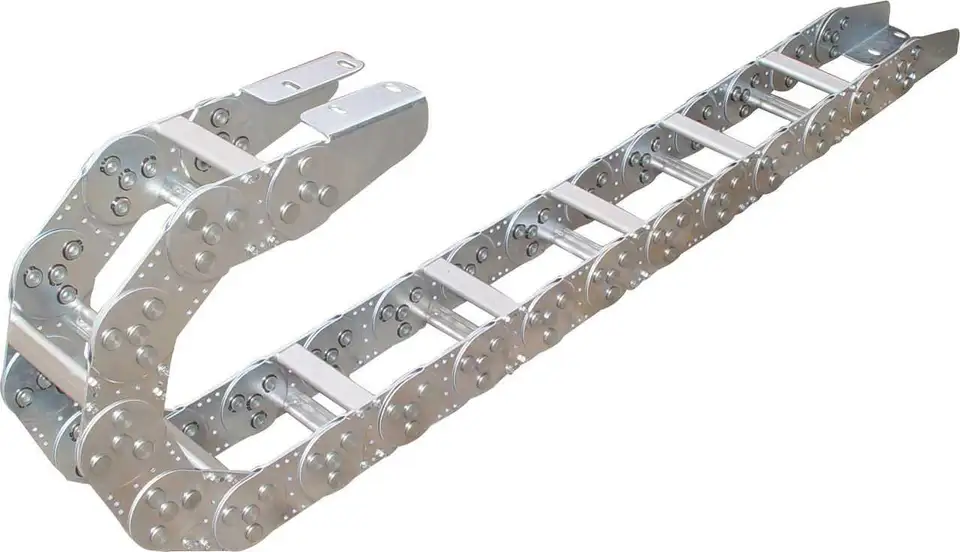
How do drag chains handle abrasive or corrosive environments?
Drag chains are designed to provide protection and guidance to cables and hoses, even in harsh and demanding environments, such as abrasive or corrosive conditions. The way drag chains handle these environments depends on the materials used, the design features, and additional protective measures.
Abrasive Environments:
In environments where abrasion is a concern, drag chains can employ materials and design features to withstand the wear and tear caused by friction and particles. Here are some considerations:
– Material Selection: Drag chains can be made from abrasion-resistant materials, such as reinforced nylon, steel-reinforced elastomers, or steel cables with plastic or rubber coatings.
– Additives: Certain additives or fillers can be incorporated into the drag chain materials to enhance their abrasion resistance properties.
– Guiding and Support: Drag chains are designed to guide and support cables and hoses, reducing their exposure to abrasive elements and minimizing potential damage.
Corrosive Environments:
For corrosive environments, drag chains must be constructed from materials that can withstand chemical exposure and prevent degradation. Here are some considerations:
– Corrosion-Resistant Materials: Drag chains can be made from materials like stainless steel or high-grade plastics that offer excellent resistance to corrosive substances.
– Coatings and Finishes: Additional coatings or finishes can be applied to the drag chain’s surface to protect against chemical attack.
– Sealing: In highly corrosive environments, drag chains may have enhanced sealing to prevent corrosive agents from entering and affecting the cables or hoses inside.
– Regular Maintenance: Proper and regular maintenance, including cleaning and inspection, can help detect and address any signs of corrosion early, prolonging the drag chain’s lifespan.
When choosing a drag chain for abrasive or corrosive environments, it’s crucial to consider the specific conditions of the application and communicate these requirements to the drag chain manufacturer or supplier. They can recommend suitable materials and designs to ensure the drag chain performs effectively and protects the cables and hoses from the harsh environment.


editor by CX 2023-11-09
China factory Reliable Quality Grain Transporting Drag Conveyor Chain Factory Price for Sale
Product Description
| Model | Effective width of machine slot(cm) | Yield(m³/H) |
| TGSS16 | 16 | 30 |
| TGSS20 | 20 | 55 |
| TGSS25 | 25 | 90 |
| TGSS32 | 32 | 130 |
| TGSS40 | 40 | 270 |
| TGSS50 | 50 | 400 |
The drag conveyor is made up with Machine head,machine body,machine tail,inlet and outlet.
(1) The machine head is made up with the main body box,drive sprocket,Gear box, transmission sprocket.Chain and drags.
(2) The tail is made up with main body box,sprocket,tensioning device.
(3) The intermediate body is made up with the tube ,slide rail chain & drags,machine cover etc.
(4) The inlet and outlet are made up with the flange and connecting joints used for input or discharge of the grain.
(5) Chain has T and V type,it is the main part of the conveyor for transportation of the grain.
(6)1t is a kind of gear box transmission ed through the chain and head shaft The drag chain conveyor is widely used in the port industry, grain warehouse,malt industry,brewery industry,feed mill company,oil factory and so on.
ZheJiang CZPT Grain Steel Silo Company Ltd. is a leading supplier of grain storage solutions in China, dedicated to providing one-stop grain storage and supporting solutions for global customers.
The company was founded in 2007, and now has more than 30 invention patents and utility model patents, nearly 8,000 square CZPT of dust-free workshop, equipped with the most advanced automatic laser cutting machine, CNC lathe, metal bending machine and automatic shearing The company has more than 10 professional designers and engineers, and hundreds of factory managers, workshop directors, production schedulers, skilled workers and installers.
1.who are you?
We are professional silo manufacturer and solution provider start from 2007 based in ZheJiang , China with 14 years experience in overseas trading.
2.how can you guarantee quality?
We have got CE, ISO9001certificates and many patents.
3.what can we buy from you?
Grain Silos, ventilation system, level sensor,silo intelligent cloud management system, weighing sensor system,sweep auger,temperature monitoring system,cooler,fumigation system for steel silo, electric control system, bucket elevator,drag conveyor, screw conveyor, belt conveyor,pneumatic conveyor, pre-cleaner, vibrating cleaner, pulse dust collector,cyclone,suction separator, magnetic drum.
4: I want to use our own brand , is it ok?
Of course it’s OK , we can make OEM products if your MOQ is 2 sets, and we can also can provide our own brand products
5:When you ship my order?
Normally 15-30 days after receiving your payment, but it can be negotiated based on order qty and production schedule.
6.what services can you provide?
Accepted Delivery Terms: FOB,CIF,EXW
Accepted Payment Currency:USD,CNY
Accepted Payment Type: T/T,L/C
Language Spoken:English,Chinese
7:How about the warranty ?
One year warranty .
| After-sales Service: | 24 Hours Online |
|---|---|
| Warranty: | One Year |
| Structure: | Conveyor System |
| Material: | Carbon Steel |
| Material Feature: | Oil Resistant, Heat Resistant, Fire Resistant |
| Application: | Grain Transport, Grain,Foodstuff,Oil,Feed Industries |
| Customization: |
Available
| Customized Request |
|---|

Can drag chains be used in the pharmaceutical and medical device manufacturing industry?
Yes, drag chains can be used in the pharmaceutical and medical device manufacturing industry, and they offer several benefits in this specific application. Here’s why:
- Cable Protection: In pharmaceutical and medical device manufacturing, there are often numerous cables and hoses that need to be protected and organized. Drag chains provide a reliable and efficient way to route and protect these cables, preventing tangling and potential damage during the manufacturing process.
- Cleanliness and Hygiene: Drag chains made from materials like stainless steel or special plastics can meet the industry’s stringent cleanliness and hygiene requirements. They are easy to clean and can withstand regular washdowns, ensuring a contamination-free manufacturing environment.
- Smooth Movement: Drag chains ensure smooth and consistent movement of cables and hoses, which is crucial in delicate medical device manufacturing processes where precision and accuracy are essential.
- Reduced Downtime: By organizing and protecting cables, drag chains help reduce the risk of cable damage and downtime due to cable-related issues. This leads to increased productivity and cost savings in the long run.
- Compliance: Drag chains can be designed to meet specific industry standards and regulations, ensuring compliance with safety and quality requirements in pharmaceutical and medical device manufacturing.
- Space Efficiency: Drag chains help in neatly organizing cables and hoses in a compact manner, optimizing the use of space in manufacturing equipment and reducing clutter.
Overall, drag chains play a crucial role in maintaining the efficiency, cleanliness, and safety of cable management in pharmaceutical and medical device manufacturing, making them a valuable component in this industry.
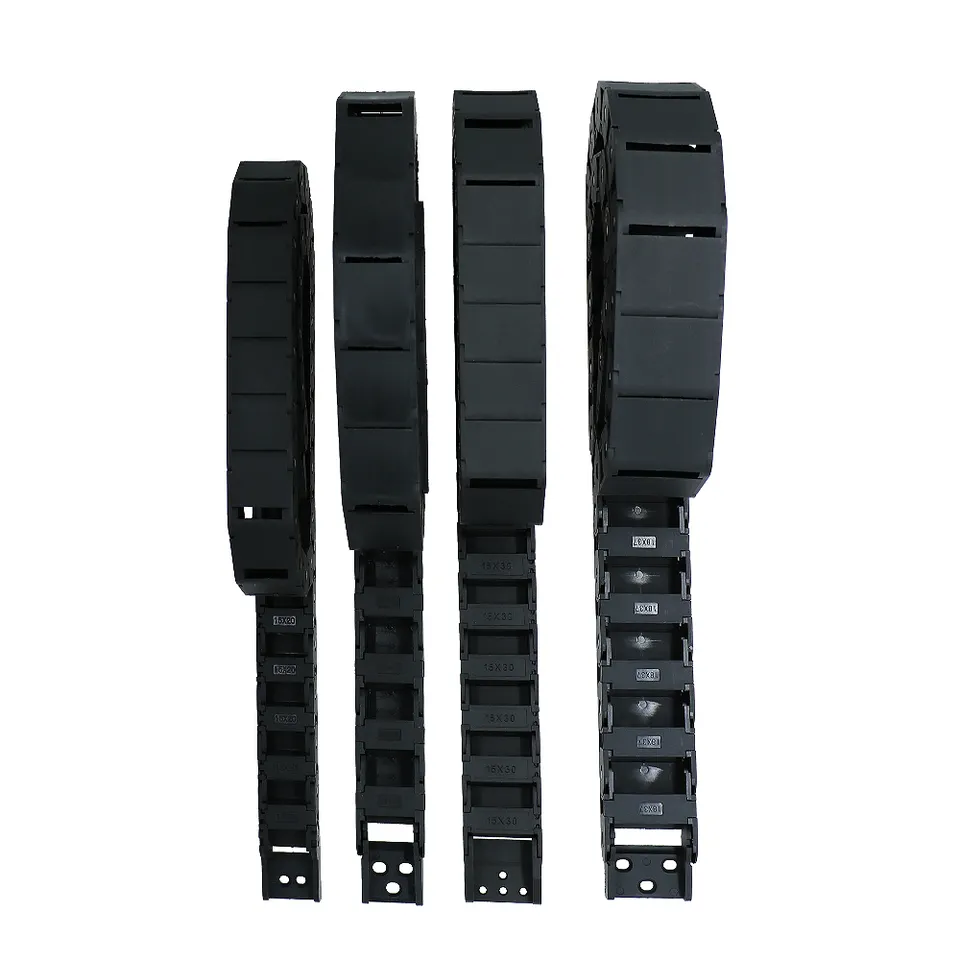
How do drag chains handle reverse motion or anti-reverse requirements?
Drag chains are designed to handle reverse motion or anti-reverse requirements in various industrial applications. When a system requires the prevention of backward movement or needs to maintain a specific orientation, anti-reverse or backstop mechanisms can be incorporated into the drag chain design. These mechanisms allow the drag chain to move freely in the desired direction while locking or resisting motion in the opposite direction.
The anti-reverse capabilities of drag chains are typically achieved through the use of specially designed components, such as one-way bearings or ratchet systems. These components allow the drag chain to engage or disengage the anti-reverse feature as needed, ensuring smooth movement in the desired direction and preventing any unintended reverse motion.
Some key points regarding how drag chains handle reverse motion and anti-reverse requirements are:
- One-Way Bearings: One-way bearings are commonly used in drag chains to enable free motion in one direction while providing resistance or locking in the opposite direction. These bearings allow the drag chain to engage with the system and move forward while preventing backward motion.
- Ratchet Mechanisms: Ratchet systems can be integrated into the drag chain to allow movement in one direction and restrict motion in the opposite direction. The ratchet mechanism engages when the drag chain moves in the intended direction and disengages when attempting to move in the reverse direction.
- Custom Solutions: In some cases, custom drag chain designs may be required to meet specific anti-reverse or backstop requirements of a particular application. Manufacturers can tailor drag chains to suit the unique needs of the system, ensuring precise control over motion and orientation.
Anti-reverse drag chains find applications in various industries where precise positioning, orientation control, or safety considerations are essential. For example, they may be used in conveyor systems to prevent products from rolling backward or in machinery that requires unidirectional movement.
When selecting a drag chain for applications that require anti-reverse capabilities, it is crucial to consider factors such as load capacity, speed, and the specific requirements of the motion control system to ensure optimal performance and reliability.
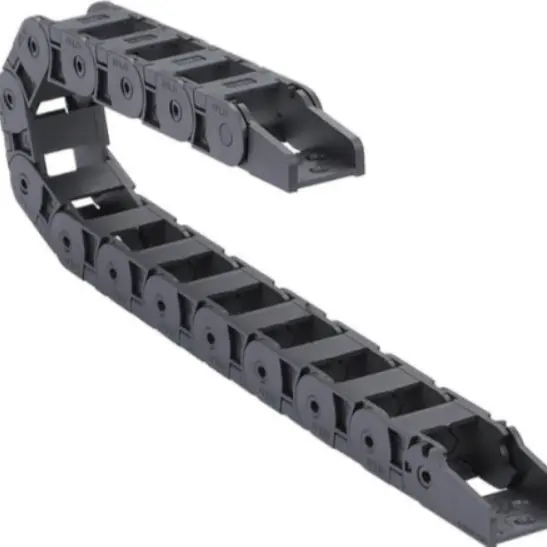
What are the maintenance requirements for drag chains?
Drag chains, like any other mechanical components, require regular maintenance to ensure their optimal performance and longevity. Proper maintenance helps prevent unexpected breakdowns, reduces downtime, and extends the service life of the drag chain. Here are the key maintenance requirements:
1. Regular Cleaning:
Periodically clean the drag chains to remove dust, debris, and any accumulated contaminants. Cleaning can be done using compressed air, a soft brush, or a mild cleaning solution. Avoid using harsh chemicals that might damage the chain’s materials.
2. Lubrication:
Some drag chains may require lubrication to reduce friction and wear. Follow the manufacturer’s recommendations for the appropriate type and frequency of lubrication. Ensure that the lubricant used is compatible with the chain’s materials.
3. Inspection:
Regularly inspect the drag chains for signs of wear, damage, or misalignment. Look for any loose or damaged links, broken components, or signs of corrosion. Address any issues found during the inspection promptly.
4. Tension Adjustment:
If the drag chain is equipped with an adjustable tension mechanism, ensure that the tension is appropriately set to prevent sagging or excessive tension. Proper tension helps maintain the chain’s stability and prolongs its life.
5. Replacement of Worn Parts:
If any components of the drag chain are worn out or damaged beyond repair, replace them with genuine replacement parts from the manufacturer. Using non-original parts can compromise the chain’s performance and durability.
6. Environmental Considerations:
Take into account the operating environment when performing maintenance. For example, if the chain is used in a dusty or corrosive environment, more frequent cleaning and inspection may be necessary.
7. Operator Training:
Train operators and maintenance personnel on the proper use and care of drag chains. Ensure they understand the maintenance requirements and can identify early signs of issues.
8. Keep Records:
Maintain a maintenance log to track cleaning, lubrication, inspections, and any maintenance or repairs performed. This record can help identify trends or patterns that might require attention.
By following these maintenance requirements, users can ensure that their drag chains operate smoothly, protect cables or hoses effectively, and contribute to the overall efficiency and reliability of the equipment in which they are installed.


editor by CX 2023-09-01
China high quality CZPT Factory Carbon Steel Drag Conveyor Chain for Silo Bulk Grain
Product Description
| Model | Effective width of machine slot(cm) | Yield(m³/H) |
| TGSS16 | 16 | 30 |
| TGSS20 | 20 | 55 |
| TGSS25 | 25 | 90 |
| TGSS32 | 32 | 130 |
| TGSS40 | 40 | 270 |
| TGSS50 | 50 | 400 |
The drag conveyor is made up with Machine head,machine body,machine tail,inlet and outlet.
(1) The machine head is made up with the main body box,drive sprocket,Gear box, transmission sprocket.Chain and drags.
(2) The tail is made up with main body box,sprocket,tensioning device.
(3) The intermediate body is made up with the tube ,slide rail chain & drags,machine cover etc.
(4) The inlet and outlet are made up with the flange and connecting joints used for input or discharge of the grain.
(5) Chain has T and V type,it is the main part of the conveyor for transportation of the grain.
(6)1t is a kind of gear box transmission ed through the chain and head shaft The drag chain conveyor is widely used in the port industry, grain warehouse,malt industry,brewery industry,feed mill company,oil factory and so on.
ZheJiang CZPT Grain Steel Silo Company Ltd. is a leading supplier of grain storage solutions in China, dedicated to providing one-stop grain storage and supporting solutions for global customers.
The company was founded in 2007, and now has more than 30 invention patents and utility model patents, nearly 8,000 square CZPT of dust-free workshop, equipped with the most advanced automatic laser cutting machine, CNC lathe, metal bending machine and automatic shearing The company has more than 10 professional designers and engineers, and hundreds of factory managers, workshop directors, production schedulers, skilled workers and installers.
1.who are you?
We are professional silo manufacturer and solution provider start from 2007 based in ZheJiang , China with 14 years experience in overseas trading.
2.how can you guarantee quality?
We have got CE, ISO9001certificates and many patents.
3.what can we buy from you?
Grain Silos, ventilation system, level sensor,silo intelligent cloud management system, weighing sensor system,sweep auger,temperature monitoring system,cooler,fumigation system for steel silo, electric control system, bucket elevator,drag conveyor, screw conveyor, belt conveyor,pneumatic conveyor, pre-cleaner, vibrating cleaner, pulse dust collector,cyclone,suction separator, magnetic drum.
4: I want to use our own brand , is it ok?
Of course it’s OK , we can make OEM products if your MOQ is 2 sets, and we can also can provide our own brand products
5:When you ship my order?
Normally 15-30 days after receiving your payment, but it can be negotiated based on order qty and production schedule.
6.what services can you provide?
Accepted Delivery Terms: FOB,CIF,EXW
Accepted Payment Currency:USD,CNY
Accepted Payment Type: T/T,L/C
Language Spoken:English,Chinese
7:How about the warranty ?
One year warranty .
| After-sales Service: | 24 Hours Online |
|---|---|
| Warranty: | One Year |
| Structure: | Conveyor System |
| Material: | Carbon Steel |
| Material Feature: | Oil Resistant, Heat Resistant, Fire Resistant |
| Application: | Grain Transport, Grain,Foodstuff,Oil,Feed Industries |
| Customization: |
Available
| Customized Request |
|---|
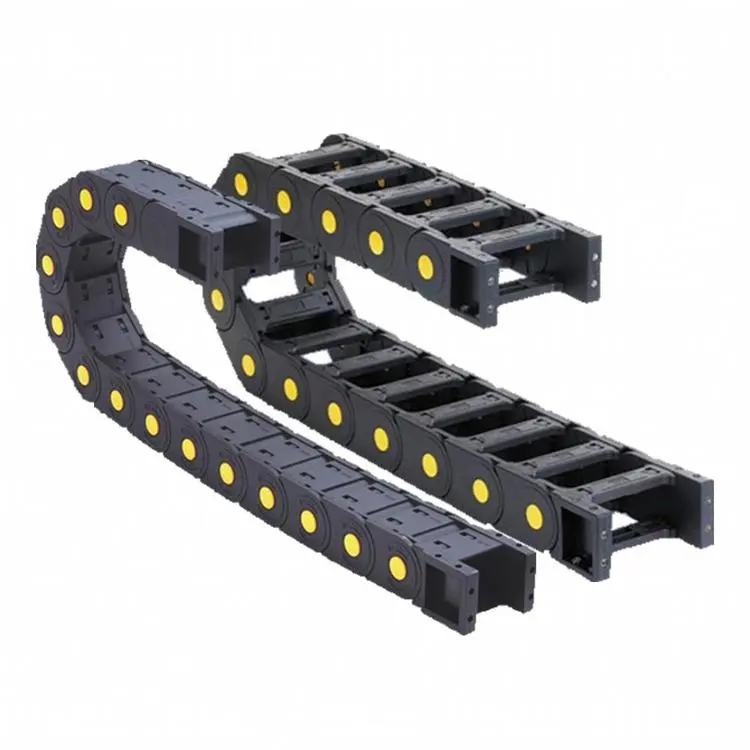
How do drag chains contribute to cable longevity and reduced downtime?
Drag chains play a significant role in enhancing cable longevity and reducing downtime in various industrial applications. Here’s how they contribute to these benefits:
- Cable Protection: Drag chains encase and protect cables and hoses, shielding them from external elements such as debris, dust, and liquids. This protection prevents the cables from getting damaged or worn out prematurely, ensuring their longevity.
- Preventing Tangling and Twisting: By guiding cables in a specific path, drag chains eliminate the risk of tangling and twisting during motion. Twisted or tangled cables can lead to damage and signal interference, which may result in downtime for troubleshooting and repairs.
- Reducing Friction: Drag chains provide a smooth pathway for cables to move within, reducing friction and abrasion that can occur when cables rub against each other or other components. Reduced friction extends the lifespan of cables and minimizes the need for frequent replacements.
- Eliminating Cable Stress: When cables are left loose or unorganized, they can be subjected to unnecessary stress during motion, which can lead to fatigue and eventual failure. Drag chains keep the cables securely in place, preventing stress-related damage.
- Preventing Cable Pinching: In some applications, cables can get pinched or crushed between moving parts. Drag chains create a dedicated channel for cables, preventing them from being pinched and preserving their integrity.
- Efficient Cable Management: Drag chains neatly organize and manage cables, reducing the chances of accidental damage or snagging during operation or maintenance activities. This efficient cable management contributes to reduced downtime and faster troubleshooting.
- Enhancing Cable Inspection: With cables enclosed in drag chains, it becomes easier to inspect and maintain them regularly. Regular inspections allow for early detection of potential issues, preventing unexpected downtime due to cable failures.
Overall, drag chains offer a comprehensive cable protection and management solution, which leads to extended cable longevity and minimized downtime in industrial settings.

Can drag chains be used in aerospace and aviation equipment?
Yes, drag chains can be used in aerospace and aviation equipment to manage and protect cables and hoses. These industries often rely on complex and sophisticated systems, and drag chains play a crucial role in ensuring the safe and reliable operation of various equipment and machinery.
In aerospace and aviation applications, drag chains offer the following benefits:
- Cable Protection: Drag chains provide a secure and enclosed pathway for cables and hoses, protecting them from potential damage caused by abrasion, impact, or environmental factors.
- Space Optimization: The compact and organized design of drag chains helps optimize space utilization in aircraft and other aviation equipment, especially in confined areas with limited room for cable routing.
- Reduced Wear and Tear: By guiding and supporting cables during movement, drag chains reduce wear and tear on cables, prolonging their lifespan and minimizing maintenance needs.
- Enhanced Safety: Drag chains prevent cables from becoming entangled or creating tripping hazards, contributing to the overall safety of the aircraft and its crew.
- Flexibility: Drag chains can accommodate cables and hoses of different sizes and types, making them suitable for a wide range of applications in the aerospace and aviation industries.
- Environmental Resistance: Drag chains are available in materials that offer resistance to temperature extremes, chemicals, and other environmental factors, ensuring reliable performance in the demanding conditions experienced during flight.
However, when using drag chains in aerospace and aviation equipment, it is essential to consider factors such as weight limitations, electromagnetic interference, and adherence to industry regulations and standards. Additionally, regular maintenance and inspection of the drag chains are critical to detect any signs of wear or damage and address them promptly to ensure continued safe and reliable operation.
Overall, drag chains provide valuable cable management solutions for aerospace and aviation applications, contributing to the efficient and safe functioning of various systems within the aircraft and related equipment.

What are the benefits of using a drag chain in industrial applications?
A drag chain, also known as a cable carrier or cable chain, offers several advantages when used in industrial applications. These benefits include:
1. Cable Protection: One of the primary benefits of using a drag chain is the protection it provides to cables and hoses. The chain encloses and shields the cables from external elements such as dust, debris, moisture, and mechanical damage. This ensures the longevity and reliability of cables, reducing the risk of downtime due to cable failure.
2. Flexibility: Drag chains are highly flexible and allow for multi-axis movement. They can bend and twist in different directions, accommodating complex motion and providing a full range of motion for cables. This flexibility is especially beneficial in applications with moving parts or robotic systems.
3. Space Optimization: By organizing and guiding cables within the drag chain, it helps optimize space and prevents cable clutter. This is particularly advantageous in tight spaces or areas with limited cable routing options, enabling efficient use of available space.
4. Reduced Wear and Tear: The smooth movement of cables within the drag chain reduces friction and wear, extending the lifespan of the cables. It prevents cables from rubbing against sharp edges or other components, mitigating the risk of abrasion and damage.
5. Improved Safety: Drag chains enhance workplace safety by eliminating loose cables and potential tripping hazards. By keeping cables organized and secure, they reduce the risk of accidents and injuries caused by tangled or exposed cables.
6. Increased Reliability: With proper cable management, the risk of cable failure due to bending, twisting, or pulling is minimized. This leads to increased reliability and uptime of machinery and equipment, improving overall productivity.
7. Resistance to Harsh Environments: Drag chains are often made from materials that offer resistance to harsh environments, such as high temperatures, chemicals, and outdoor elements. This makes them suitable for a wide range of industrial applications, including those in rugged and demanding conditions.
8. Easy Installation and Maintenance: Drag chains are designed for easy installation and maintenance. They can be opened easily for adding or removing cables, simplifying the process of cable updates or replacements.
Overall, the use of drag chains in industrial applications ensures efficient cable management, protects cables from damage, and contributes to the safe and reliable operation of machinery and equipment.


editor by CX 2023-07-25